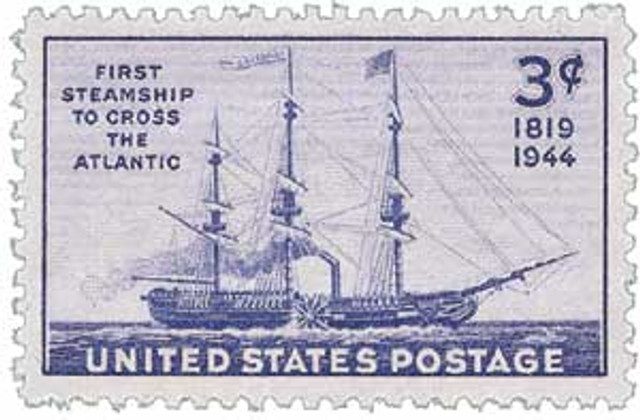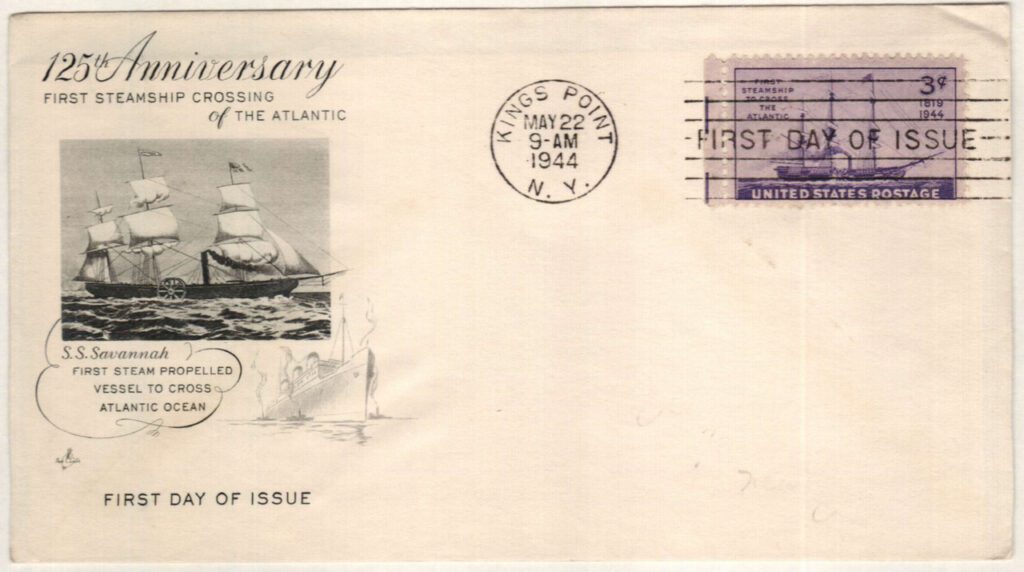On June 20, 1819, the SS Savannah arrived in Liverpool, England, becoming the first steamship to cross the Atlantic Ocean.
The Savannah was original developed as a sailing packet at the New York shipyard of Fickett & Crockett in 1818. While the ship was still being constructed, Captain Moses Rogers convinced a prosperous shipping firm from Savannah, Georgia, to purchase the ship, convert it to a steamship, and gain the attention and a place in history as the first transatlantic steamship service.
The firm agreed and then had the ship fitted with an auxiliary steam engine and paddle wheels, while still maintaining its sails. The ship was built too small to carry larger amounts of fuel, so the engine would mostly be used during calm weather and would depend on the sails otherwise. The Savannah is also the only known ship to be fitted with retractable paddle wheels.
When news of the ship’s planned transatlantic voyage became public, some called it a steam coffin and Rogers was unable to get men to join the crew. He then went to his hometown of New London, Connecticut, where he was known as a successful ship captain and was able to recruit the crew he needed.
On March 22, 1819, the Savannah took a trial run of two hours in New York harbor. It then embarked on its first voyage on March 28 from New York to Savannah. The ship arrived in Savannah at 4 am on April 6 to a large, enthusiastic crowd.
On May 11, President James Monroe visited Georgia and took a trip on the Savannah. They traveled to Tybee Lighthouse and back. The president was impressed with the ship and encouraged its owner to bring it to Washington after the transatlantic voyage so Congress could inspect it and possibly purchase it for use against Cuban pirates.
In the weeks leading up to the voyage, the Savannah’s owners attempted to get passengers and freight for the journey, but no one wanted to take the risk. So when the Savannah departed Georgia on May 22, 1819, it was purely experimental, with no passengers (aside from the crew) aboard. They stopped at Tybee Lighthouse and then embarked on their journey at 5 am on May 24.
On May 29, the schooner Contract saw the ship from a distance emitting large amounts of smoke. They assumed the ship was on fire and followed it for several hours, but were never able to catch up. They later discovered it had been the steamship Savannah and the Contract’s commander said it was “a proud moment of Yankee skill and enterprise.” On June 2, the Savannah passed the sailing ship Pluto, whose crew gave the steamship three cheers as “the happiest effort of mechanical genius that ever sailed the western sea.” Yet another ship spotted the smoking Savannah on June 19. The Irish ship HMS Kite couldn’t catch up to it so they fired a series of warning shots, which led captain Rogers to halt. The Irish sailors then caught up, came aboard, and were very impressed.
Finally, on June 20, the Savannah reached Liverpool, England. There it was greeted by hundreds of ships in the harbor. They dropped anchor at 6 pm, bringing their trip to an end after 29 days and 11 hours. Of that though, they used the steam engine for a total of only 80 hours (about 11% of the journey). Because most of the voyage was completed with the use of sails, some question its place as the first steamship to cross the Atlantic. Some cite the SS Royal William as the first successful steamship to cross the Atlantic, as it only used its sails during one day of boiler maintenance.
Many thousands of people visited the Savannah while it was in Liverpool for 25 days. It then left on July 21 and made stops in Denmark and Sweden, becoming the first steamship in the Baltic Sea. From there it went to Russia where it conducted several excursions for prominent citizens and diplomats. Both the Russian and Swedish governments tried to buy the ship but Rogers refused. The Savannah returned home on November 30.
However, the following January, a fire destroyed much of the city of Savannah, including the owners’ office, and they were forced to sell the ship. The engine was removed and the Savannah was converted back to a sailing ship. It then ran aground on November 5, 1821. While the Savannah’s story was cut short, it proved that a steamship was capable of crossing the ocean. It would be another 20 years before steamships would make regular Atlantic crossings.
| FREE printable This Day in History album pages Download a PDF of today’s article. Get a binder or other supplies to create your This Day in History album. |
Discover what else happened on This Day in History.





Great part of our history that is not widely stated. Thank you for this bit of history.